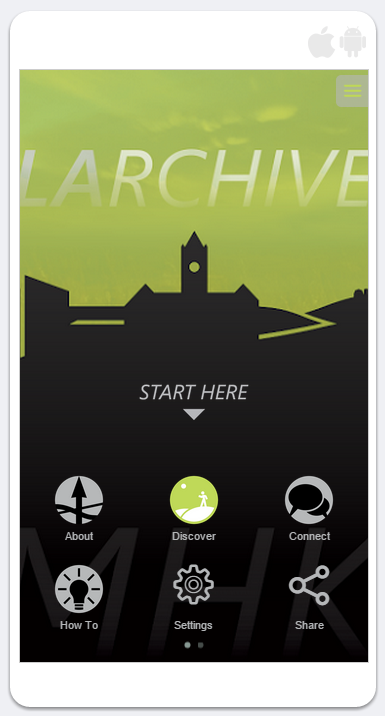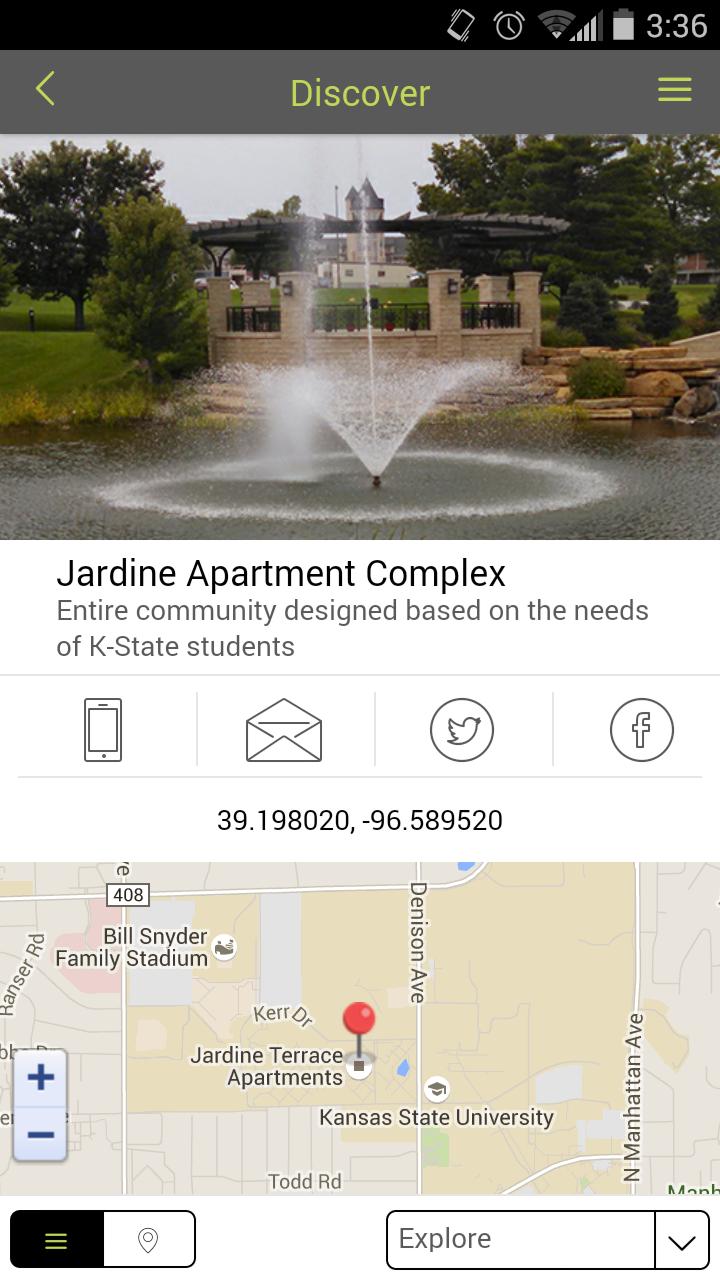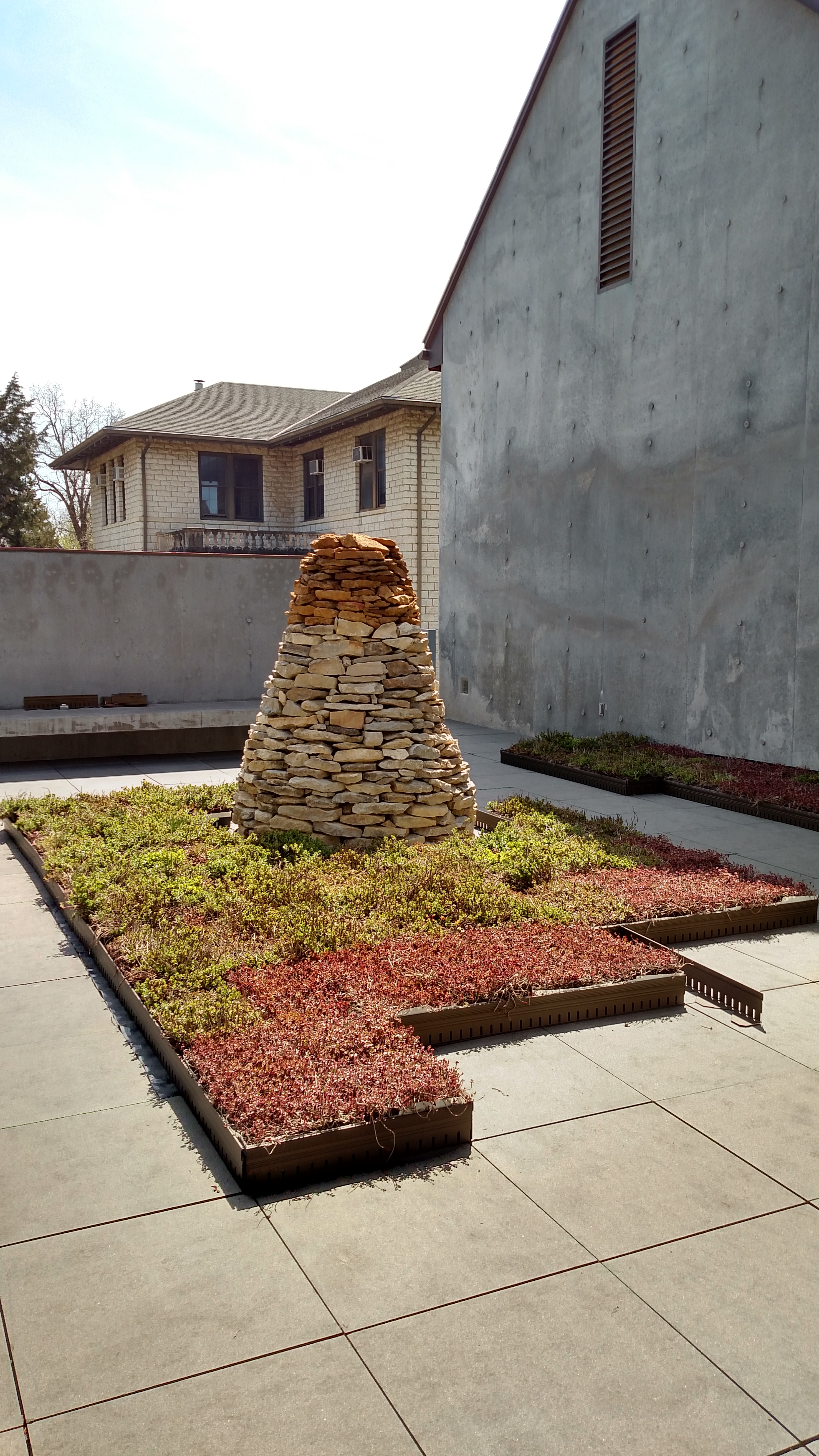Students create a digital presence for landscape architecture in Manhattan
This past spring, two landscape architecture students dove into a world of coding, marketing and app creation in hopes of spreading the word of landscape architecture and winning the national Wayne Grace Memorial Competition.
The Landscape Architectural Registration Boards Foundation, CLARB, which supports landscape architecture education and research, hosts the annual competition. Entries were challenged to effectively communicate to the public, non-landscape architects, about one or more of the seven impacts of landscape architecture on welfare as identified by CLARB.
MLA 4th years Neal Heidt and Timothy Kellams set out to create something unique for the competition as part of a class assignment in LAR 442, Site Planning and Design.
“It first started with my dad, who had recently asked me to explain exactly what landscape architecture is,” Tim said. “I found it a lot easier to explain the profession by providing him with references or examples of places that he has been to that are considered landscape architecture.”
The LArchive was created as an app to help the public know and understand their built environment around them, primarily through landscape architecture. The app is based in Manhattan, Kansas, but it has the ability to be adapted to just about any town or city. The app’s goal is for users to realize the importance of the practices of landscape architecture in their everyday lives, hopefully leading to a greater appreciation and understanding of the profession.
The primary function of LArchive is the “Discover” tool, a database of 40-plus designed landscapes in the Manhattan area. This tool features basic information about each site (including a photo, GPS coordinates with navigation capabilities, contact information, and popular activities), along with an explanation of the asset and opportunity each site possesses. The opportunity is paired with a listing of case studies of landscape architecture projects, which have been successful in addressing similar opportunities.
Generating and refining the concept of LArchive took Tim and Neal about 6 weeks. They spent the following two weeks gathering and importing data. Then, had 8 weeks to receive and apply feedback from professors, critics and consultant.
Throughout this time the team created a workflow. Tim would focus on compiling data and writing the content for the app, and Neal would work out the logistics, design the branding identity, and revise the writing. The two used several types of software throughout the project including:
- BuildFire to build the app
- Google and Google Maps to find information about specific places
- Google Forms to compile and revise data
- Adobe Photoshop and Illustrator to design the interface and graphics
- Facebook and Twitter to market the app
“Google Forms was probably the most essential program to our project, because it allowed us to collect and revise data no matter where we were at, and to import it straight into BuildFire within a matter of minutes,” both said. “This was important because there was a time when we both got mentally fatigued from this project and just needed to get out of Seaton Hall.”
Neal and Tim drew from their own experiences and those of trustworthy friends to compile data. The two also spent one Saturday traveling throughout Manhattan to visit the sites they were unfamiliar with to absorb them through taking notes and pictures.
What was one of the most difficult parts of this project for the duo?
“Well…the name of the app was a struggle for sure,” Neal said. “We wanted something that was catchy but sounded like an app used to better understand the landscape. Neal and I would have late phone calls after leaving studio in the wee hours of the morning about the name of the app. Neal suggested the name LArchive, which covered our primary goals for the name: catchy and related to the profession. In short, LArchive is “landscape architecture” (LA) and ‘archive’ (our app is a database) put together.”
Another difficulty was “balancing working on the app, working on other parts of the competition, and working on projects for other classes,” Tim added. “It’s all about time management and we had to make sure we were on top of things.”
While waiting for academic feedback for the project , the two went a step further and launched a thorough marketing campaign with a limited budget. Both Neal and Tim attribute word of mouth as one of the biggest asset to the app’s success. However, Twitter, Facebook and a print campaign also occurred.
“We placed posters in the halls of Seaton and handed out fliers at the Council of Educators in Landscape Architecture (CELA) conference, which was held this year in Manhattan,” Tim said. “We sent out push notifications directly to users’ phones informing them of updates within the app.”
Social media marketing helped the two conduct more research about the places featured in the app and published these facts on social media as a weekly series called #FridayFact. They also had a second weekly series, #TuesdayTip, which gave helpful tidbits on ways to use LArchive.
In May the app went through a rebrand. The goal was to simplify the brand’s identity, so that there was nothing distracting from the goals of the app itself. The main change was to the original slogan of the app, ‘Dig and discover!’
“After the beta launch of the app, we decided we wanted to be much clearer with our intentions. We got rid of the slogan, because it almost seemed unnecessary to us to have one, given the nature of the project,” Neal said.
The app is currently available for download on both Apple and Android markets, for tablets and mobile devices alike. The original intent for the app was to publish it as a concept for how landscape architecture could be promoted in any city throughout the world. You’ll notice that when you download the app, the text below the icon as well as the logo on the home screen both read “LArchive MHK.” This was an intentional component to the name.
When asked what the future holds for the app, the two said if LArchive proves to be an effective marketing tool in the field of landscape architecture as a whole, they would like to see it carried through in other cities.
“If LArchive presents itself in the future as a full time project with prospects that benefit the industry as a whole, I may be interested in revisiting it,” Neal said. “However, due to my limited knowledge of code and our lack of large scale marketing resources, I believe that to carry this project any further than it already is would be a full-time project for someone with a significant background in both coding and marketing.”
The results of the competition will be announced in August, along with a $10,000 prize.
The duo has asked that if alumni have any questions, ideas or feedback about the app to email them at contact.larchive@gmail.com.
Interact or download the MHK LAarchive >
View projects created by fellow LAR 442 classmates >
Tim and Neal would like to thank the following people for their supportive efforts in launching the app.
Advisers
Blake Belanger, Associate Professor, Landscape Architecture, instructor of LAR 442
Alpa Nawre, Assistant Professor, Landscape Architecture, instructor of LAR 442
Stephanie Rolley, Professor & Department Head, Landscape Architecture and Regional & Community Planning
Development Consultant
Seth Goings, Software Developer, ReadyTalk
Creativity Consultants
Aaron Schump, Assistant Professor, Architecture
Andrea Hansen, Guest Lecturer, Landscape Architecture, Harvard University
Jon Hunt, Associate Professor, Landscape Architecture
Content Consultants
Kaitlin Bernal, Student, Landscape Architecture
Richard Dean Prudenti, Student, Landscape Architecture
Financial Assistance
Department of Landscape Architecture and Regional & Community Planning
Photography
Andrew Rostek, Student, Landscape Architecture
Brianna Sprague, Graphic Designer, APDesign College
Conner Bruns, Student, Landscape Architecture
Jackie Gehrt; Student; Fisheries, Wildlife and Conservation Biology
Jonathan Knight, Student, Landscape Architecture
Kelsey Steward, Student, Landscape Architecture
Kelsie Shy, Student, Landscape Architecture
Laura Vallo, Student, Landscape Architecture
Lee Skabelund, Associate Professor, Landscape Architecture
Richard Dean Prudenti, Student, Landscape Architecture
‘Cairns on the Beach’ brings Kansas History of Built Stone Structures to Campus
During the Fall 2014 and Spring 2015 semesters, LARCP students and professors, along with K-State art students, collaborated with American Crop Artist Stan Herd in creating an installation at the Marianna Kistler Beach Museum of Art on campus.
The artistic installation, which features dry stone cairns, along with a green roof, envisioned by Herd was inspired by stacked rock sculptures in the woods near Perry Lake. The piece was conducted in two phases, the first focusing on the dry stone and the second focusing on the green roof aspect.
Howard Hahn and Katie Kingery-Page, both LARCP associate professors, served as advisors for the project. Participating landscape architecture students were Diane Cocchiara, Beth Krehbiel and Nicholas Mercado
The installation will remain on display through the spring 2017 semester to allow visitors to view the work in a full range of seasons. Below you will find a series of photos that were taken throughout the installation.

















